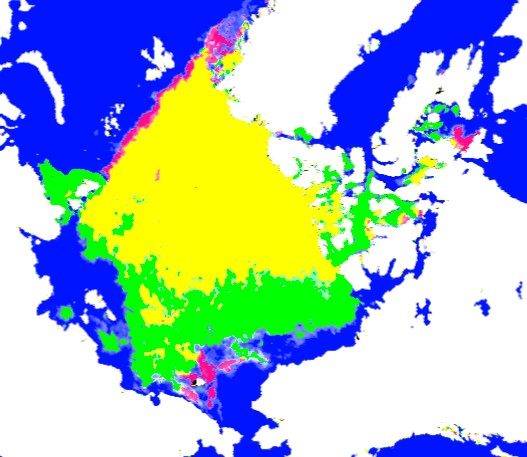There has been a massive increase in Arctic sea ice since the first week of August 2012 (green area below) – but it is worse than it seems. Note that almost all of the new ice is on the Alaska side of the Arctic, This means that almost all of the remaining ice in a few weeks will also survive the winter (i.e. not get transported out the Fram Strait.)
By next spring, it is all multi-year ice and thus harder to melt going into next summer.
The undeath spiral continues.



true that…
Had to laugh when the wind piled the ice up….and people were acting hysterical about a hole
Now there’s a hockey stick:
http://arctic-roos.org/observations/satellite-data/sea-ice/observation_images/ssmi1_ice_area.png
I fully expect “adjustments” to do their magic now, but this situation may reveal what conditions lead to an increasing ice paradigm.
Exactly Steve, that’s precisely why Mark Serreze’s “fluke” comment on the Bering Sea ice back in 2010 is significant. Alaska has rapidly cooled the past ~7+ years, which totally blindsided the Warmastrologists.
More starving bears because ice too thick.
Reblogged this on The Firewall.
Notice how one major place where there is less ice (pink) is in Fram Strait itself. That is not due, (I think,) because it is all that much warmer in Fram Strait, but rather because so much less ice is being flushed down that way. On at least three occasions the “North Pole Camera” has stopped heading south towards Fram Strait, and nudged back northward a bit. If the ice isn’t exiting the Arctic Ocean, it is simple common sense that there will be more left up there.
In a sense this year is the opposite of 2007, which was a year of super-flushing. But you just wait and see. The same people who claimed that year’s low ice extant was due to warming will say this year’s greater extent is only due to currents. In fact they will likely say it is due to currents CAUSED by warming. (Sigh)
This is an excellent point. Barring any major event in the Arctic in the next four weeks, there will be a much greater amount of 2 and 3 year old ice in the Arctic next summer. What puzzles me, though, is why we didn’t see much of a rebound after 2010. And 2006 saw a large amount of ice left in the area of Alaska at about this date in the year but the winds of 2007 still blew much of it out of the Arctic. It is rather difficult to correlate the ice of one year to the ice of the previous year. Years with a lot of ice seem like they can have a following year with little and years with little (2007) seem they can be followed by a year with much more (2008). Also note that at the time, 2006 was the record low year before 2007 came along.
I believe you have to include solar radiations in the equation to get a better “prognostic” of the next year’s ice. 2008 IMO was a typical example (and 2009), another one is the increase in the Arctic icecap in the 1970’s that occurred during the end of cycle 20 (around 1976). If this assumption is correct then we have a good prospect of more recovery in the coming years as cycle 24 is starting its descending phase now. Another important factor I believe is the SST anomaly of the N. Atlantic: during the “warm years” of the WWII (in the Arctic) the AMO was at its peak and from 2003 to 2007 it was also having a large positive anomaly. Now the AMO is giving signs of going less positive.
All parameters seem to indicate important recovery of the Arctic ice in the years ahead.
Neven is very unhappy about the current situation.
You can see the ice off Alaska with the web cams on the tow active ocean buoys (7 and 8).
http://obuoy.datatransport.org/monitor#buoy7/camera
I love the irony when the trinkets purchased to document glow-bull warming perform so nicely in documenting reality vs. the alarmista’s fevered imaginations. i.e. maybe a slight cooling trend.
Likely the same non-trend that had the previous generation of alarmists bloviating about global cooling….
Found polar bear on movie for http://obuoy.datatransport.org/monitor#buoy7/camera click on movie on bottom tab at 5:16 into movie polar bear shows up
Steve et al., Does anyone think that one part of the Antarctic sea ice will eventually freeze up to the southernmost tip of South America? http://nsidc.org/data/seaice_index/images/daily_images/S_bm_extent_hires.png
Just looking at it by eye, looks pretty close to me. And I wonder when was the last time it happened?
It goes and come back,
http://climate4you.com/SeaIce.htm#Southern%20Hemisphere%20Monthly%20Sea%20Ice
but at some point it may go and stay, and may start to spread over S. America!!
Maybe we’re witnessing the beginning of a new glacial period. 🙂
Here is link http://obuoy.datatransport.org/monitor#buoy7/movie
Climate scientists say that the green bit on that map above is actually grass growing in the hot arctic weather and the red bit is rose farms.